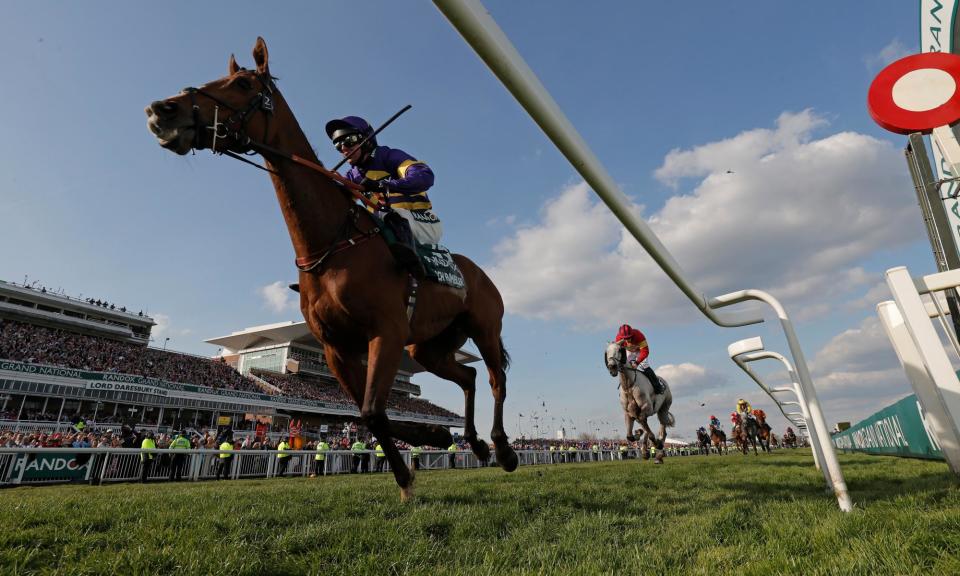What Corach Rambler’s retirement says about racing’s direction of travel

Lucinda Russell described the decision to retire Corach Rambler, her 2023 Grand National winner, as one “laced with sadness” yet “joyous” last week and the gelding’s many fans and backers knew exactly what she meant. Cheaply bought and owned by a syndicate who paid £3,000 a share, Corach Rambler’s rise through the chasing ranks to win twice at the Cheltenham festival and then land jumping’s most famous and valuable race was an unalloyed feelgood story that also seems to have concluded a chapter or two too soon.
Corach Rambler was, after all, the first British-trained horse across the line when he finished third in the Cheltenham Gold Cup in March. At 10 years of age, he is, officially at least, qualified for “veterans” events, but reaching double figures has not prevented stars including Sprinter Sacre, Cue Card, Silviniaco Conti, Faugheen and Un De Sceaux from adding Grade One wins to their record in the past decade. Corach Rambler’s final race, when he was pulled up in the Punchestown Gold Cup last month, was his 15th start over fences.
Related: Seize the Grey, owned by thousands, wins Preakness to thwart Mystik Dan’s Triple Crown bid
If his fans find it hard to say goodbye so suddenly, it must have been even harder for his owners, for whom he was the horse of a lifetime. Admittedly, Corach Rambler had an unfortunate experience when attempting to win a second National at Aintree in April when he unseated Derex Fox at the first and then fell while running loose at the second and he looked a shadow of his former self in Ireland a couple of weeks later. But even so, it must have been a huge temptation to write it off as a race too far in the current campaign, before giving him a long summer holiday and aiming towards the spring of 2025.
It seems the potential glory and earnings in Corach Rambler’s future were outweighed by the possibility that Aintree had left a permanent mark and, perhaps more significantly, the certainty of a lifetime of regret should he fail to return from a future outing. The imbalance between risk and reward, when there had been so much of a reward already, was simply too great.
So, well done to the Ramblers, Russell and Peter Scudamore, the trainer’s partner and assistant, for appreciating that. As the trainer put it last week: “We have a great responsibility with a horse with his public following to do the best thing for him.”
Russell added: “Maybe [Aintree] frightened him a bit. We have said all along that he is one of the most intelligent horses we have ever trained and he never looked happy when we ran at Punchestown.”
When it comes to jumps horses, popularity that breaks through with the general sporting public will always be a double-edged sword. Desert Orchid survived the fall in the home straight in the 1991 King George that marked the end of his racing career. Another hugely popular grey, One Man, was not so fortunate when he crashed through the ninth in the Melling Chase at Aintree in 1998, barely a fortnight after winning the Champion Chase at Cheltenham.
At the same time, though, the big names pull in the punters and as a recent winning favourite in the Grand National Corach Rambler was one of the few horses in training whose name may ring a vague bell with people outside the immediate racing bubble. He will, no doubt, be back at Aintree in April for years to come for the parade of past champions, but that alone will not shift many tickets for an event that, like Cheltenham in March, is suddenly struggling to hang on to its live audience.
The problem is not as serious at Aintree yet, but like the Cheltenham festival, this year’s Grand National meeting suffered a drop in attendance for the second year running. The crowd for the National was 55,822, down 4.1% on 2023 and a chunky 14% – or 9,080 racegoers – from the post-Covid high of 64,902 in 2022. The meeting as a whole attracted 120,259 spectators this year, down 13.6% since 2022.
Racing’s total attendance in 2023 was 4.83m, an identical figure to 2022 and despite the significant drops at Cheltenham attendance at British tracks in the first three months of this year was up by 2.5% on 2023. It is not all bad news, in other words, but that two of the sport’s showpiece events – and the two biggest revenue earners for Jockey Club Racecourses – are struggling for spectators remains a serious cause for concern.
Edward Gillespie, who did more than any individual horse, trainer or jockey to turn the Cheltenham festival into a huge annual fixture in the sporting calendar, suggested to the Racing Post last week that the meeting needs a “tournament director” focused only on the festival to steer through the changes required to arrest its decline. He also suggested that the decline in the number of horses rated 150 or above in UK stables has been “frightening”. Twenty-four hours later, Corach Rambler – with a rating of 162 – was officially retired.
It has always been a paradox that what is best for an individual horse may not necessarily be what is best for racing. But it is feels increasingly acute at a time when crowds for the spring festivals seem to be melting away.

